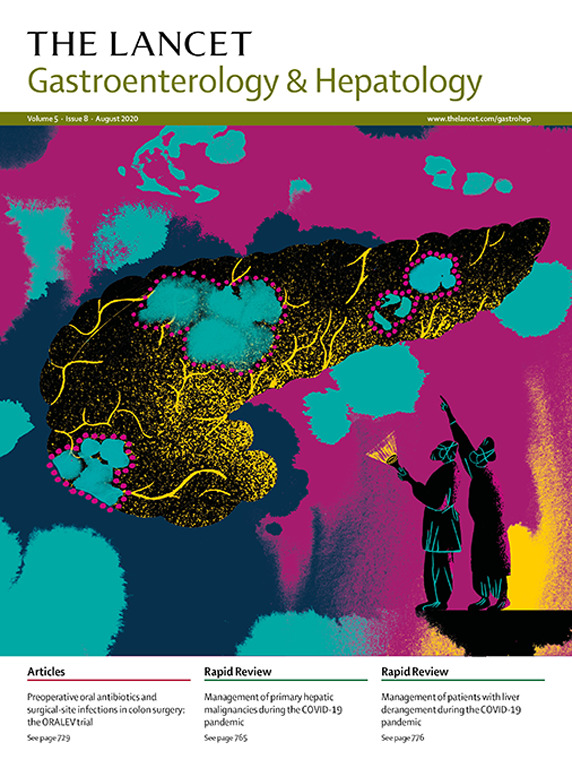Per-oral endoscopic myotomy versus laparoscopic Heller's myotomy plus Dor fundoplication in patients with idiopathic achalasia: 5-year follow-up of a multicentre, randomised, open-label, non-inferiority trial
IF 30.9
1区 医学
Q1 GASTROENTEROLOGY & HEPATOLOGY
引用次数: 0
Abstract
Background
In this trial, we previously showed per-oral endoscopic myotomy (POEM) to be non-inferior to laparoscopic Heller's myotomy (LHM) plus Dor fundoplication in managing symptoms in patients with idiopathic achalasia 2 years post-procedure. However, post-procedural gastro-oesophageal reflux was more common after POEM at 2 years. Here we report 5-year follow-up data.Methods
This study is a multicentre, randomised, open-label, non-inferiority trial performed at eight centres in six European countries (Germany, Italy, Czech Republic, Sweden, the Netherlands, and Belgium). Patients with symptomatic primary achalasia were eligible for inclusion if they were older than 18 years and had an Eckardt symptom score higher than 3. Patients were randomly assigned (1:1; randomly permuted blocks of sizes 4, 8, or 12) to undergo either POEM or LHM plus Dor fundoplication. The primary endpoint was clinical success, defined by an Eckardt symptom score of 3 or less without the use of additional treatments, at 2 years, and was reported previously. Prespecified secondary endpoints at 5 years were clinical success; Eckardt symptom score; Gastrointestinal Quality of Life Index score; lower oesophageal sphincter function by high-resolution manometry; and parameters of post-procedural reflux (reflux oesophagitis according to the Los Angeles classification; pH-metry, and DeMeester clinical score). We hypothesised that POEM would be non-inferior (with a non-inferiority margin of –12·5 percentage points) to LHM plus Dor fundoplication with regards to clinical success. All analyses were performed on a modified intention-to-treat (mITT) population, which included all patients who underwent the assigned procedure. This study is registered with ClinicalTrials.gov (NCT01601678) and is complete.Findings
Between Dec 7, 2012, and Oct 9, 2015, 241 patients were randomly assigned (120 to POEM and 121 to LHM) and 221 had the assigned treatment (112 POEM and 109 LHM; mITT). 5-year follow up data were available for 90 (80%) patients in the POEM group and 87 (80%) patients in the LHM group. Clinical success rate at 5 years was 75·0% (95% CI 66·2 to 82·1) after POEM and 70·8% (61·7 to 78·5) after LHM (difference 4·2 percentage points [95% CI –7·4 to 15·7]). The mean Eckardt symptom score decreased from baseline to 5 years in both groups and the overall difference in mean scores was –0·29 (95% CI –0·62 to 0·05). Change in Gastrointestinal Quality of Life Index scores, as well as in integrated relaxation pressure on manometry, from baseline to 5 years, did not differ significantly between the groups. At 5 years, 26 (41%) of 63 patients after POEM and 18 (31%) of 58 patients after LHM had reflux oesophagitis (difference 10·2 percentage points [95% CI –7·0 to 26·8]). Significant oesophagitis (Los Angeles classification grade B, C, or D) was observed in nine (14%) of 63 patients after POEM and in four (7%) of 58 patients after LHM. pH-metry was performed in 81 (37%) of 221 patients, with higher mean acid exposure time for POEM (10·2% [95% CI 7·6 to 14·2]) than for LHM (5·5% [3·1 to 11·8]). Significantly more patients in the POEM than in the LHM group had abnormal acid exposure time at 5 years (>4·5%; 28 [62%] of 45 vs 11 [31%] of 36; difference 31·7 percentage points [95% CI 9·8 to 50·5]). The presence of reflux symptoms at 5 years was similar in both groups, with a mean DeMeester clinical score of 1·3 (95% CI 1·0 to 1·6) after POEM and 1·1 (0·9 to 1·4) after LHM. The complications of peptic stricture, Barrett's oesophagus, and oesophageal adenocarcinoma were not reported.Interpretation
Our long-term results support the role of POEM as a less invasive myotomy approach that is non-inferior to LHM in controlling symptoms of achalasia. Gastro-oesophageal reflux was common in both groups, but with a tendency towards higher rates in the POEM group. Thus, patients should be provided with the advantages and disadvantages of each approach in decision making.Funding
European Clinical Research Infrastructure Network, Hamburgische Stiftung für Wissenschaften, Entwicklung und Kultur Helmut und Hannelore Greve, Dr med Carl-August Skröder Stiftung, Dr Gerhard Büchtemann Stiftung, Agnes-Graefe Stiftung, Georg und Jürgen Rickertsen Stiftung, Reinhard Frank Stiftung, Johann Max Böttcher Stiftung, Richard und Annemarie Wolf Stiftung, Olympus Europa, German Society for Gastroenterology and Metabolism and Olympus Europe Foundation, United European Gastroenterology Week, Olympus EuroNOTES Research Fund Program, Harvard Catalyst, the Harvard Clinical and Translational Science Center, and Harvard University and its affiliated academic health-care centres.背景在这项试验中,我们曾发现在特发性贲门失弛缓症患者术后 2 年的症状控制方面,经口内镜下肌切开术(POEM)并不优于腹腔镜海勒氏肌切开术(LHM)加多尔胃底折叠术。然而,POEM术后2年胃食管反流的情况更为常见。本研究是一项多中心、随机、开放标签、非劣效试验,在六个欧洲国家(德国、意大利、捷克共和国、瑞典、荷兰和比利时)的八个中心进行。有症状的原发性贲门失弛缓症患者只要年龄在18岁以上,且埃卡症状评分高于3分,就有资格被纳入试验。患者被随机分配(1:1;大小为4、8或12的随机排列区块)接受POEM或LHM加Dor胃底折叠术。主要终点是临床成功,即在不使用额外治疗的情况下,埃卡症状评分达到或低于 3 分,时间为 2 年。5 年的预设次要终点是临床成功率、埃卡尔特症状评分、胃肠道生活质量指数评分、高分辨率测压法得出的下食道括约肌功能以及术后反流参数(根据洛杉矶分类法得出的反流性食管炎、pH 值测量法和 DeMeester 临床评分)。我们假设 POEM 在临床成功率方面不劣于 LHM 加 Dor 胃底折叠术(非劣效差为-12-5 个百分点)。所有分析均在改良意向治疗(mITT)人群中进行,包括所有接受指定手术的患者。该研究已在ClinicalTrials.gov(NCT01601678)上注册,并已完成。研究结果在2012年12月7日至2015年10月9日期间,241名患者被随机分配(120名患者接受POEM治疗,121名患者接受LHM治疗),221名患者接受了指定治疗(112名患者接受POEM治疗,109名患者接受LHM治疗;mITT)。POEM组有90名(80%)患者接受了5年随访,LHM组有87名(80%)患者接受了5年随访。POEM 组 5 年临床成功率为 75-0%(95% CI 66-2 至 82-1),LHM 组为 70-8%(61-7 至 78-5)(相差 4-2 个百分点 [95% CI -7-4 至 15-7])。从基线到 5 年期间,两组患者的平均埃卡症状评分均有所下降,平均评分的总体差异为-0-29(95% CI -0-62至0-05)。胃肠道生活质量指数评分以及测压时的综合松弛压力从基线到 5 年的变化在两组之间没有显著差异。5 年后,63 名接受 POEM 治疗的患者中有 26 人(41%)患有反流性食管炎,58 名接受 LHM 治疗的患者中有 18 人(31%)患有反流性食管炎(差异为 10-2 个百分点 [95% CI -7-0 至 26-8])。221例患者中有81例(37%)进行了pH测定,POEM的平均酸暴露时间(10-2% [95% CI 7-6 to 14-2])高于LHM(5-5% [3-1 to 11-8])。5年后,POEM组出现异常酸暴露时间的患者明显多于LHM组(45例中的28例[62%]对36例中的11例[31%];差异为31-7个百分点[95% CI 9-8至50-5])。两组患者 5 年后出现反流症状的情况相似,POEM 患者的平均 DeMeester 临床评分为 1-3(95% CI 1-0 至 1-6),LHM 患者的平均 DeMeester 临床评分为 1-1(0-9 至 1-4)。在控制贲门失弛缓症症状方面,POEM 作为一种创伤较小的肌切开术,其效果并不亚于 LHM。胃食管反流在两组患者中都很常见,但 POEM 组的反流率更高。因此,患者在做决定时应了解每种方法的优缺点。资助机构欧洲临床研究基础设施网络、汉堡科学、发展与文化基金会(Helmut und Hannelore Greve)、Carl-August Skröder 医学博士基金会、Gerhard Büchtemann 博士基金会、Agnes-Graefe 基金会、Georg und Jürgen Rickertsen 基金会、Reinhard Frank 基金会、Johann Max Böttcher 基金会、Richard und Annemarie Wolf Stiftung、Olympus Europa、德国胃肠病学与代谢学会和奥林巴斯欧洲基金会、欧洲联合胃肠病周、奥林巴斯 EuroNOTES 研究基金项目、哈佛催化剂、哈佛临床与转化科学中心、哈佛大学及其附属学术医疗中心。
本文章由计算机程序翻译,如有差异,请以英文原文为准。
求助全文
约1分钟内获得全文
求助全文
来源期刊

Lancet Gastroenterology & Hepatology
Medicine-Hepatology
CiteScore
50.30
自引率
1.10%
发文量
0
期刊介绍:
The Lancet Gastroenterology & Hepatology is an authoritative forum for key opinion leaders across medicine, government, and health systems to influence clinical practice, explore global policy, and inform constructive, positive change worldwide.
The Lancet Gastroenterology & Hepatology publishes papers that reflect the rich variety of ongoing clinical research in these fields, especially in the areas of inflammatory bowel diseases, NAFLD and NASH, functional gastrointestinal disorders, digestive cancers, and viral hepatitis.
 求助内容:
求助内容: 应助结果提醒方式:
应助结果提醒方式:


